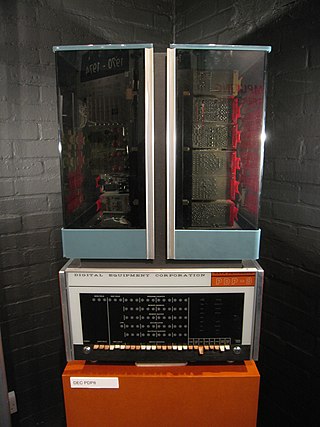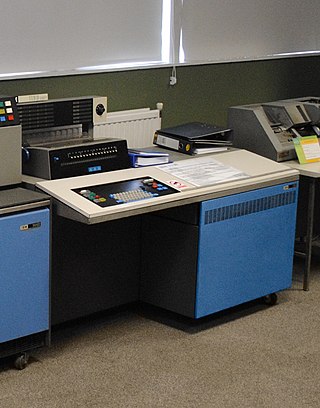Related Research Articles

In a computer's central processing unit (CPU), the accumulator is a register in which intermediate arithmetic logic unit results are stored.

The Data General Nova is a series of 16-bit minicomputers released by the American company Data General. The Nova family was very popular in the 1970s and ultimately sold tens of thousands of units.

The PDP-8 is a family of 12-bit minicomputers that was produced by Digital Equipment Corporation (DEC). It was the first commercially successful minicomputer, with over 50,000 units being sold over the model's lifetime. Its basic design follows the pioneering LINC but has a smaller instruction set, which is an expanded version of the PDP-5 instruction set. Similar machines from DEC are the PDP-12 which is a modernized version of the PDP-8 and LINC concepts, and the PDP-14 industrial controller system.

The LINC is a 12-bit, 2048-word transistorized computer. The LINC is considered by some to be the first minicomputer and a forerunner to the personal computer. Originally named the Linc, suggesting the project's origins at MIT's Lincoln Laboratory, it was renamed LINC after the project moved from the Lincoln Laboratory. The LINC was designed by Wesley A. Clark and Charles Molnar.

The IBM 650 Magnetic Drum Data-Processing Machine is an early digital computer produced by IBM in the mid-1950s. It was the first mass-produced computer in the world. Almost 2,000 systems were produced, the last in 1962, and it was the first computer to make a meaningful profit. The first one was installed in late 1954 and it was the most popular computer of the 1950s.
MIX is a hypothetical computer used in Donald Knuth's monograph, The Art of Computer Programming (TAOCP). MIX's model number is 1009, which was derived by combining the model numbers and names of several contemporaneous, commercial machines deemed significant by the author. Also, "MIX" read as a Roman numeral is 1009.

The IBM 700/7000 series is a series of large-scale (mainframe) computer systems that were made by IBM through the 1950s and early 1960s. The series includes several different, incompatible processor architectures. The 700s use vacuum-tube logic and were made obsolete by the introduction of the transistorized 7000s. The 7000s, in turn, were eventually replaced with System/360, which was announced in 1964. However the 360/65, the first 360 powerful enough to replace 7000s, did not become available until November 1965. Early problems with OS/360 and the high cost of converting software kept many 7000s in service for years afterward.

The IBM 1130 Computing System, introduced in 1965, was IBM's least expensive computer at that time. A binary 16-bit machine, it was marketed to price-sensitive, computing-intensive technical markets, like education and engineering, succeeding the decimal IBM 1620 in that market segment. Typical installations included a 1 megabyte disk drive that stored the operating system, compilers and object programs, with program source generated and maintained on punched cards. Fortran was the most common programming language used, but several others, including APL, were available.
The Simplified Instructional Computer is a hypothetical computer system introduced in System Software: An Introduction to Systems Programming, by Leland Beck. Due to the fact that most modern microprocessors include subtle, complex functions for the purposes of efficiency, it can be difficult to learn systems programming using a real-world system. The Simplified Instructional Computer solves this by abstracting away these complex behaviors in favor of an architecture that is clear and accessible for those wanting to learn systems programming.

The HP 2100 is a series of 16-bit minicomputers that were produced by Hewlett-Packard (HP) from the mid-1960s to early 1990s. Tens of thousands of machines in the series were sold over its twenty-five year lifetime, making HP the fourth largest minicomputer vendor during the 1970s.
In computer engineering, an orthogonal instruction set is an instruction set architecture where all instruction types can use all addressing modes. It is "orthogonal" in the sense that the instruction type and the addressing mode vary independently. An orthogonal instruction set does not impose a limitation that requires a certain instruction to use a specific register so there is little overlapping of instruction functionality.

The Western Design Center (WDC) 65C02 microprocessor is an enhanced CMOS version of the popular nMOS-based 8-bit MOS Technology 6502. It uses less power than the original 6502, fixes several problems, and adds new instructions. The power usage is on the order of 10 to 20 times less than the original 6502 running at the same speed; its reduced power consumption has made it useful in portable computer roles and industrial microcontroller systems. The 65C02 has also been used in some home computers, as well as in embedded applications, including medical-grade implanted devices.
CESIL, or Computer Education in Schools Instruction Language, is a programming language designed to introduce pupils in British secondary schools to elementary computer programming. It is a simple language containing a total of fourteen instructions.
NAR 2 is a theoretical model of a 32-bit word computer created by Faculty of Mathematics of University of Belgrade professor Nedeljko Parezanović as an enhancement to its predecessor, NAR 1. It was used for Assembly language and Computer architecture courses. The word "nar" means Pomegranate in Serbian. Many NAR 2 simulators have been created — for instance, one was named "Šljiva" as that fruit grows in Serbia, while "nar" does not.

The Elliott 803 is a small, medium-speed transistor digital computer which was manufactured by the British company Elliott Brothers in the 1960s. About 211 were built.

The Little Man Computer (LMC) is an instructional model of a computer, created by Dr. Stuart Madnick in 1965. The LMC is generally used to teach students, because it models a simple von Neumann architecture computer—which has all of the basic features of a modern computer. It can be programmed in machine code or assembly code.
The D-37C (D37C) is the computer component of the all-inertial NS-17 Missile Guidance Set (MGS) for accurately navigating to its target thousands of miles away. The NS-17 MGS was used in the Minuteman II (LGM-30F) ICBM. The MGS, originally designed and produced by the Autonetics Division of North American Aviation, could store multiple preprogrammed targets in its internal memory.
Ferranti's Sirius was a minicomputer released in 1961. Designed to be used in smaller offices without a dedicated programming staff, the Sirius used decimal arithmetic instead of binary, supported Autocode to ease programming, was designed to fit behind a standard office desk, and ran on UK standard mains electricity with no need for cooling. It was also fairly slow, with instruction speeds around 4,000 operations per second, and had limited main memory based on delay lines, but as Ferranti pointed out, its price/performance ratio was difficult to beat.
ICT 1900 was a family of mainframe computers released by International Computers and Tabulators (ICT) and later International Computers Limited (ICL) during the 1960s and 1970s. The 1900 series was notable for being one of the few non-American competitors to the IBM System/360, enjoying significant success in the European and British Commonwealth markets.
The Hack Computer is a theoretical computer design created by Noam Nisan and Shimon Schocken and described in their book, The Elements of Computing Systems: Building a Modern Computer from First Principles. In using the term “modern”, the authors refer to a digital, binary machine that is patterned according to the von Neumann architecture model.
References
Citations
- 1 2 3 Herbert 2015, p. 20.
- 1 2 3 Computer, p. 1.
- 1 2 3 4 5 6 7 8 9 Herbert 2015.
- ↑ Computer, p. 3.
- ↑ Computer, p. 7.
- ↑ ICL, p. 2.6.
- ↑ Computer, p. 4.
- 1 2 ICL.
- ↑ Computer, p. 6.
- ↑ Computer, pp. 6–7.
- 1 2 ICL, p. 13.
- ↑ ICL, p. 11.
- ↑ ICL, p. 5.0.
- ↑ ICL, p. 6.1.
- ↑ ICL, p. 2.8.
- ↑ Computer, pp. 2–3.
- ↑ ICL, p. 13.0.
- ↑ Herbert 2015, p. 25.
Bibliography
- Herbert, Andrew (Autumn 2015). "City and Guilds Mnemonic Code" (PDF). Computer Resurrection: The Journal of the Computer Conservation Society (71): 20–27. ISSN 0958-7403.
- City & Guilds Mnemonic Code. ICL.
- The City & Guilds Computer (PDF). ICL.